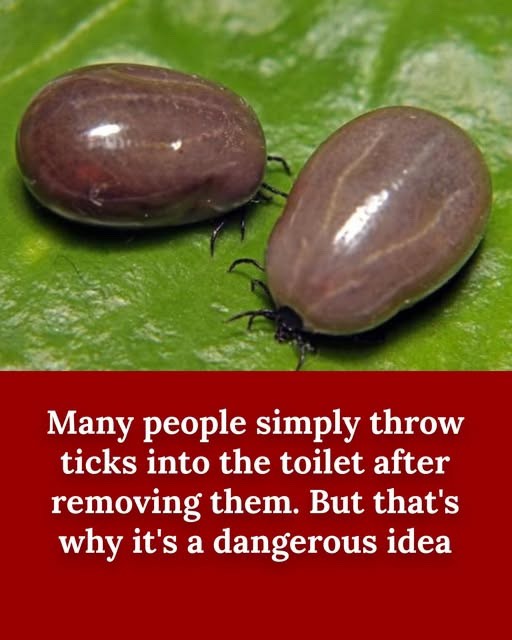Many people instinctively flush ticks down the toilet after removing them from their skin or their pets, believing it’s an effective and final way to dispose of them. However, the reality of whether ticks can survive a toilet flush is more complicated. While it’s true that ticks are incredibly resilient creatures known for their ability to survive in extreme conditions, their fate in a toilet bowl depends on several factors, including water temperature, pH levels, and the length of time they remain submerged. Understanding tick behavior and the best methods for disposal is essential to ensure these tiny parasites are completely eliminated.

Can Ticks Survive Being Flushed Down the Toilet?
Despite their reputation for toughness, ticks are not well-equipped to handle water. They cannot swim, nor can they climb out of the smooth, slippery surfaces of a toilet bowl. Once submerged, they are at risk of drowning, especially if they remain underwater for an extended period. However, their resilience means that some ticks may survive, particularly if they find a surface to cling to within the bowl.
While the swirling water of a flush might seem like an efficient way to kill a tick, it’s not always guaranteed. Some ticks can endure the experience, clinging to the bowl’s surface or simply surviving due to their low oxygen requirements and hardy exoskeleton. This is why some experts recommend other disposal methods that provide a higher chance of eliminating the tick completely.
Why Are Ticks So Resilient?
Ticks are built to survive harsh conditions. Their tough exoskeleton serves as armor, protecting them from physical harm and environmental stressors. Hard ticks, like those from the Ixodidae family, can go months without feeding and withstand both high and low temperatures. Soft ticks (Argasidae), while slightly less durable, still possess impressive survival capabilities.
When submerged in water, ticks face multiple survival challenges. First, toilet water is typically much colder than their natural habitat, which can shock their system and slow their metabolism. Second, prolonged immersion prevents them from accessing oxygen, and exposure to chlorinated water can further compromise their ability to survive.
Despite these challenges, ticks are known to endure conditions that would kill many other insects, making them one of the most resilient pests you might encounter.
How to Properly Remove and Dispose of Ticks
Proper tick removal is critical to reducing the risk of disease transmission. If a tick feels threatened or is improperly removed, it may regurgitate its stomach contents into the bite wound, increasing the chance of infection.
- Use Fine-Tipped Tweezers: Grasp the tick as close to the skin as possible and pull upward with steady, even pressure.
- Avoid Twisting or Jerking: This can cause parts of the tick’s mouth to remain embedded in the skin.
- Do Not Use Petroleum Jelly or Heat: These methods can irritate the tick and increase the risk of disease transmission.
- Clean the Area Thoroughly: After removal, disinfect the bite site and your hands with rubbing alcohol or soap and water.
For disposal, avoid flushing the tick down the toilet. Instead, opt for one of the following methods:
- Rubbing Alcohol: Submerge the tick in a container of rubbing alcohol to ensure it is killed.
- Hot Water: Drop the tick in boiling water.
- Sealed Bag: Place the tick in a sealed plastic bag before discarding it in the trash.
- Tape Method: Secure the tick between two pieces of tape and dispose of it in the trash.
Understanding Tick Habitats and Behavior
Ticks thrive in damp, shaded environments such as wooded areas, tall grasses, and leaf piles. They latch onto humans and animals by sensing carbon dioxide, body heat, and movement. Once attached, ticks use their specialized mouthparts to anchor themselves and feed on their host’s blood.
Ticks are found worldwide, with higher concentrations in regions with dense vegetation and warm climates. They are known vectors for various diseases, including Lyme disease and Rocky Mountain spotted fever, making proper tick management essential for health and safety.
Preventing Tick Infestations in Your Home
Preventing ticks from entering your home is key to avoiding tick bites and infestations. Here are some effective prevention strategies:
- Keep Windows and Doors Closed: Open doors and windows can serve as entry points for ticks.
- Install Screens: Use screens on all windows and doors to prevent insect entry.
- Maintain a Tidy Yard: Regularly mow the lawn, clear leaf piles, and remove debris.
- Use Insect Repellent: Apply tick repellents to entry points like window sills and baseboards.
- Inspect Pets: Regularly check your pets for ticks after they’ve been outdoors.
- Hire a Professional Exterminator: If you live in an area with high tick populations, consider professional pest control services for inspections and treatments.
Final Thoughts
While flushing a tick down the toilet might seem like a quick and easy disposal method, it’s not always effective. Ticks are incredibly resilient and may survive the flush under certain conditions. For more reliable results, use rubbing alcohol, boiling water, or secure the tick in a sealed bag before disposal.
Proper tick removal, disposal, and prevention are critical in minimizing the risks associated with tick bites and the diseases they can carry. By taking these precautions, you can better protect yourself, your family, and your pets from the dangers posed by these persistent parasites.





